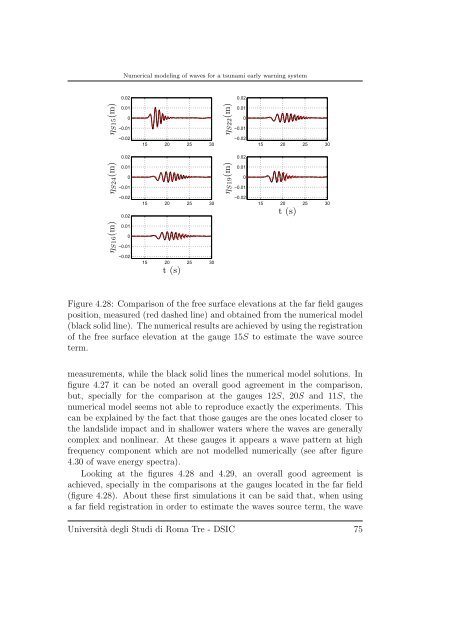Numerical modeling of waves for a tsunami early warning system
Numerical modeling of waves for a tsunami early warning system
Numerical modeling of waves for a tsunami early warning system
Create successful ePaper yourself
Turn your PDF publications into a flip-book with our unique Google optimized e-Paper software.
ηS15(m)<br />
ηS24(m)<br />
ηS16(m)<br />
<strong>Numerical</strong> <strong>modeling</strong> <strong>of</strong> <strong>waves</strong> <strong>for</strong> a <strong>tsunami</strong> <strong>early</strong> <strong>warning</strong> <strong>system</strong><br />
0.02<br />
0.01<br />
0<br />
−0.01<br />
−0.02<br />
0.02<br />
0.01<br />
0<br />
−0.01<br />
−0.02<br />
0.02<br />
0.01<br />
0<br />
−0.01<br />
−0.02<br />
15 20 25 30<br />
15 20 25 30<br />
15 20 25 30<br />
t(s)<br />
ηS22(m)<br />
ηS19(m)<br />
0.02<br />
0.01<br />
0<br />
−0.01<br />
−0.02<br />
0.02<br />
0.01<br />
0<br />
−0.01<br />
−0.02<br />
15 20 25 30<br />
15 20 25 30<br />
t(s)<br />
Figure 4.28: Comparison <strong>of</strong> the free surface elevations at the far field gauges<br />
position, measured (red dashed line) and obtained from the numerical model<br />
(black solid line). The numerical results are achieved by using the registration<br />
<strong>of</strong> the free surface elevation at the gauge 15S to estimate the wave source<br />
term.<br />
measurements, while the black solid lines the numerical model solutions. In<br />
figure 4.27 it can be noted an overall good agreement in the comparison,<br />
but, specially <strong>for</strong> the comparison at the gauges 12S, 20S and 11S, the<br />
numerical model seems not able to reproduce exactly the experiments. This<br />
can be explained by the fact that those gauges are the ones located closer to<br />
the landslide impact and in shallower waters where the <strong>waves</strong> are generally<br />
complex and nonlinear. At these gauges it appears a wave pattern at high<br />
frequency component which are not modelled numerically (see after figure<br />
4.30 <strong>of</strong> wave energy spectra).<br />
Looking at the figures 4.28 and 4.29, an overall good agreement is<br />
achieved, specially in the comparisons at the gauges located in the far field<br />
(figure 4.28). About these first simulations it can be said that, when using<br />
a far field registration in order to estimate the <strong>waves</strong> source term, the wave<br />
Università degli Studi di Roma Tre - DSIC 75

















